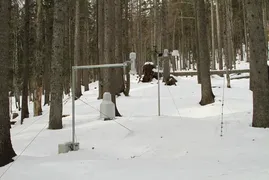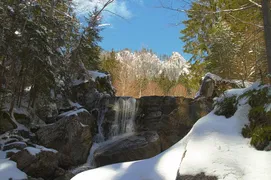The runoff performance and therefore the emergence of flooding incidents can be affected by snowmelt occurrences especially in catchment areas located in the alpine upland. In those regions it is necessary to accurately display snow hydrological processes like snow accumulation and snow melting in the hydrological model. Before 2014, only conceptional approaches were available in the hydrological model WaSiM (Schulla 1997). For instance, the temperature-index-method (including modifications) is to determine the melting rate or temperature dependent storage principles for an illustration of the snow accumulation. Both of them demonstrate a parameterization based on the tangible heat flow and therefore, primarily of the geodetic height. Therefore, the simulation of the runoff performance caused problems during spring.
In 2014, the simulation of the snow processes in WaSiM was significantly improved due to the implementation of the energy balance model (Warscher et al. 2013, released 09/2014). At the same time, the accumulation behaviour next to the melting behaviour of snow is apart from the geodetic height and respectively air temperature additionally influenced by more regional parameters. Those parameters include topography and land usage by interception of snow, which is considered to be substantially higher compared to rain interception. Following development potentials for WaSiM arise for the ProMoS research projects:
- Advancement of the energy balance model by considering the topography and landuse-dependent shading effects (especially forests), which have a big influence on the radiation, temperature, humidity, and on the overall energy balance of the snow cover.
- Advancement of the snow accumulation module by considering the topography and a landuse-dependent snow interception
In order to gain a clearer understanding of this process, a metrological analysis of the snow hydrological procedures that include the regional dependencies is necessary. Therefore, a suitable measuring strategy will be generated within the development project. Based on this, measuring systems for the monitoring of relevant parameters like the snow cover, solid precipitation and other meteorological input variables will be installed in representative study areas. The ensuing measurement results are used for verification of the developed component models. The approaches which are implemented in the water balance model are then validated with the help of representive examplary areas that have corresponding spacial data and time-series.
Investor: Bayerisches Staatsministerium für Umwelt und Verbraucherschutz
Projektbeginn: 01.08.2015
Projektende: 31.12.2018
Projektleitung: Dipl.-Ing. Matthias Kopp, Prof. Dr.-Ing. Markus Disse
Projektbearbeitung: Dipl.-Ing. Matthias Kopp (matthias.kopp@tum.de)

